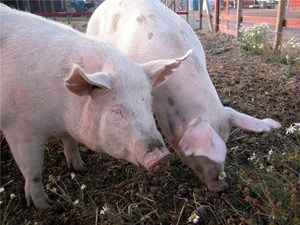 A major change is afoot in the world of public health, as the U.S. Food and Drug Administration has recently announced a move to limit the use of antibiotics, or antimicrobial drugs, in farm animals.1 The FDA’s announcement will have wide-ranging effects and could impact most health care professions, from pharmacists to certified medical assistants to veterinary technicians. These drugs have long been used to promote growth in livestock that is being raised for food production. However, health authorities all around the world have been warning the U.S. and other countries for years that antibiotics could lead to any number of dangerous and scary outcomes in public health.
A major change is afoot in the world of public health, as the U.S. Food and Drug Administration has recently announced a move to limit the use of antibiotics, or antimicrobial drugs, in farm animals.1 The FDA’s announcement will have wide-ranging effects and could impact most health care professions, from pharmacists to certified medical assistants to veterinary technicians. These drugs have long been used to promote growth in livestock that is being raised for food production. However, health authorities all around the world have been warning the U.S. and other countries for years that antibiotics could lead to any number of dangerous and scary outcomes in public health.
Antibiotics in American livestock
The FDA released a report in April showing that 81 percent of the raw turkey meat it tested contained antibiotic-resistant bacteria.2 And while that number is alarmingly high, other meats also displayed a similar abundance, including 69 percent of pork chops, 55 percent of ground beef and 39 percent of chicken. Not only that, but according to the Pew Charitable Trusts, there was nearly four times as many pounds of antibiotics sold for use in animals in 2011 as there were for humans – 29.9 million for animals versus 7.7 million for humans. “Antibiotic use in animals is out of hand,” Dr. Gail Hansen, a veterinarian and senior officer for the Pew Campaign on Human Health and Industrial Farming, told CNN. “We feed antibiotics to sick animals, which is completely appropriate, but we also put antibiotics in their feed and in their water to help them grow faster and to compensate for unhygienic conditions. If you have to keep the animals healthy with drugs, I would argue you need to re-examine the system.”
Curbing the use of antibiotics
In response to rapidly expanding human populations in the 20th century, and the need to feed them, large agribusinesses started using a broad spectrum of drugs and hormones designed to stimulate growth in animals and bring more efficiency to food production. But as immunologists began to gain a greater understanding of the dangers of antimicrobial resistance in humans and animals, a campaign began to limit their use to avoid things like disease epidemics. The widespread use of antibiotics serves to reduce their effectiveness as time goes on, and even create new, drug-resistant diseases. Those diseases, sometimes referred to as superviruses, could eventually lead to the kinds of outbreaks that health authorities have long feared. The FDA, working with agriculture businesses in the U.S., will soon implement a policy phasing out the regular use some of those antibiotics, or limiting them to cases where they are medically necessary. “We need to be selective about the drugs we use in animals and when we use them,” William Flynn, DVM, MS, deputy director for science policy at FDA’s Center for Veterinary Medicine (CVM), said in a press conference on Dec. 11. “Antimicrobial resistance may not be completely preventable, but we need to do what we can to slow it down.”
FDA guidelines
In a document released by the FDA, guidelines for pharmaceutical companies that make drugs for animals are laid out explaining how they can work with the agency to remove feed efficiency and growth enhancement indications from their most medically important drugs. Those drugs would then be subject to veterinary oversight, as opposed to being available over the counter, and they would be labeled as such. Upon that voluntary implementation of the guidelines, affected products would only be used to prevent, treat or care for diseases in animals. “This action promotes the judicious use of important antimicrobials, which protects public health and, at the same time, ensures that sick and at-risk animals receive the therapy they need,” CVM Director Bernadette Dunham, DVM, Ph.D, said in a statement.
Impact on the pharmaceutical and veterinary industries
While antibiotics help produce larger animals while using less feed, they also lead to a buildup of immunity to dangerous germs that also affect humans, like Staphylococcus and C. difficile.3 With its announcement to institute greater oversight of pharmaceutical companies and veterinarians alike, the FDA will attempt to limit the use of the most common of these antibiotics, including penicillin and tetracycline. The two largest manufacturers of animal pharmaceuticals, Elanco and Zoetis (a subsidiary of Pfizer), have already signed on to the new standards. That voluntary cooperation from companies that hold the biggest market share in the industry should help adherence to the guidelines trickle down to smaller manufacturers. Veterinarians and veterinary technicians will now also be relied on more than ever to make sound judgments on when, how and whether to use antibiotics on their patients. As the majority of antibiotic use in animals shifts from promoting growth to purely medicinal purposes, people in the veterinary profession will become the mediators in many ways between the FDA and pharmaceutical companies. 1 “Phasing out Certain Antibiotic Use in Farm Animals,” U.S. Food and Drug Administration, Dec. 11, 2013. http://www.fda.gov/ForConsumers/ConsumerUpdates/ucm378100.htm 2 CNN Staff, “FDA Hopes to Curb Antibiotic Use on Farms,” CNN.com, Dec. 11, 2013. http://www.cnn.com/2013/12/11/health/fda-antibiotics-farms/?hpt=he_c1 3 Reinberg, Steven, “FDA to Limit Use of Antibiotics in Farm Animals,” U.S. News & World Report, Dec. 11, 2013. http://health.usnews.com/health-news/news/articles/2013/12/11/fda-to-limit-use-of-antibiotics-in-farm-animals



